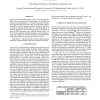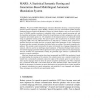13 search results - page 1 / 3 » Automatic disfluency removal for improving spoken language t... |
ICASSP
2010
IEEE
13 years 4 months ago
2010
IEEE
Statistical machine translation (SMT) systems for spoken languages suffer from conversational speech phenomena, in particular, the presence of speech dis uencies. We examine the i...
COLING
2010
12 years 11 months ago
2010
Unrehearsed spoken language often contains disfluencies. In order to correctly interpret a spoken utterance, any such disfluencies must be identified and removed or otherwise deal...
NAACL
2004
13 years 6 months ago
2004
The regular occurrence of disfluencies is a distinguishing characteristic of spontaneous speech. Detecting and removing such disfluencies can substantially improve the usefulness ...
EMNLP
2009
13 years 2 months ago
2009
While speaking spontaneously, speakers often make errors such as self-correction or false starts which interfere with the successful application of natural language processing tec...
MT
2002
13 years 4 months ago
2002
We present MARS (Multilingual Automatic tRanslation System), a research prototype speech-to-speech translation system. MARS is aimed at two-way conversational spoken language trans...


